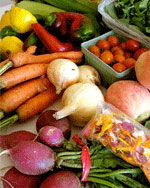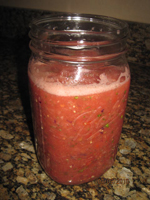The colorful bounty of foods readily available this time of year, evidenced by strolling through the grocery’s produce section, or at a lively farmers’ market, reminds us that Mother Nature is on full display! From the spectral range of green, black, purple, and red grapes, to the equally colorful varieties of peppers, tomatoes, and chilies, it is a rainbow of nutrition. The juicy stone fruits—nectarines, plums, apricots, pluots, peaches—are the taste of the sun embodied. And strawberries and watermelons are quintessentially summer foods—if there ever was a time to eat foods in season, it is definitely summer.
But Mother Nature’s offerings are not just beautiful and tasty—seasonal foods also help us to stay healthy. Take for instance watermelon—it is a sweet, watery, cooling food, perfect to keep us hydrated and our heat tempered on hot summer days. Berries and juicy stone fruits are excellent sources of water-soluble vitamin C, and they contain naturally-occurring sugars for quick energy, which are tempered by the fruits’ fiber content. Summer squash have a cooling aspect, helping our bodies to overcome the heat we feel in the atmosphere, and they are a natural diuretic. Peppers are also cooling, while chilies are pungent, making them diaphoretic–sweat-inducing–in action; this actually helps us to cool down when it’s hot outside. In fact, the commonly held practice of icing drinks and consuming iced foods when it’s hot outside can be detrimental to our health in the summer time. Consider it this way: The nature of cold is to contract, and consuming ice-cold fare actually slows the digestion and keeps the heat trapped inside! Better to reach for room temperature or warmed foods, even in the summer.
This is the perfect time of year to cook foods lightly—a quick grilling, gently steaming, or lightly sautéing—or to even enjoy them raw. In the Chinese medical tradition, the digestive fire can be harmed by eating too much raw food, so the best time of year to enjoy foods raw is during the summer, when the heat of the environment helps to support our bodies’ warm digestive energy. An added bonus from this type of food preparation is that valuable heat-sensitive vitamins and enzymes are left intact.
In Chinese Five Element theory, summer is the season of Fire. The Fire element also has its own flavor—bitter—that can be found plentifully in the foods of the season. The nature of bitter is to contract and move downward, a great counter to the effusive tendencies this time of year. Cucumbers, bean sprouts, eggplants, peppers, lettuces, vinegar, lemon and lime all imbue the bitter flavor to dishes. Adding this flavor to a recipe can help to drain dampness in the form of puffiness and edema, move constipation and settle overly-robust constitutions.
 While this a great season for enjoying produce, having a bit of steamed, whole grains, such as organic brown rice, whole oats or wheat berries is a great way to add more fiber and complex carbohydrates to your diet, and they are all good sources of B-vitamins, which help support the nervous system. Rinse them well, then soak them for at least 6 hours at room temperature, preferably with a couple tablespoons of active-culture kefir or yogurt, then cook them, adding additional water as needed. Soaking grains in this manner improves their bioavailability by reducing components that inhibit their digestion and helps break down complex starches and proteins. In other words, soaking grains, especially with a live culture, pre-digests your food.
While this a great season for enjoying produce, having a bit of steamed, whole grains, such as organic brown rice, whole oats or wheat berries is a great way to add more fiber and complex carbohydrates to your diet, and they are all good sources of B-vitamins, which help support the nervous system. Rinse them well, then soak them for at least 6 hours at room temperature, preferably with a couple tablespoons of active-culture kefir or yogurt, then cook them, adding additional water as needed. Soaking grains in this manner improves their bioavailability by reducing components that inhibit their digestion and helps break down complex starches and proteins. In other words, soaking grains, especially with a live culture, pre-digests your food.
Lighter protein fare is a terrific choice for this time of year, as well. Beans and legumes are great sources of protein, especially adzuki, mung, garbanzo and lima beans, as well as lentils—all of these options have a neutral or cooling temperature. Try them sprouted: Simply rinse, soak, drain, and then allow the sprouting to occur, continuing to rinse and drain every 8-12 hours over the next 2-3 days. This YouTube link is a great tutorial.
Sprouting beans and legumes increases their vitamin and enzyme composition greatly, and, like adding cultures to soaking grains, helps to predigest the bean or legume being sprouted, making their nutrients more bioavailable.
You can also enjoy beans and legumes cooked—rinse and soak them, drain off the water, then use fresh water with any vegetables, seasonings and herbs you like, as you cook them until tender. You can even take cooked beans and puree them in a food processor or blender, with a drizzle of extra virgin olive oil, and serve them as a bean pate, similar to hummus. Using herbs and seasonings popular in different regions—garlic, oregano and basil for Italian; cumin, chili powder and onion for Mexican; turmeric and curry for Indian—is a great way to set the tone for a given appetizer or meal accompaniment.
Chinese medicine also holds that eating some animal protein is a very healthful practice, to sustain Qi and Blood—if you are so inclined, having about 4 ounces of organic chicken, turkey or wild-caught fish, paired with a mixed vegetable salad, will be a very nutritious lunch or dinner option. Grilling is a great way to cook meat in the summer—just be sure to not blacken the meats. Burning the flesh of meats has been shown to greatly increase chemicals in the foods that have been linked to cancer. Marinate meats with lemon or vinegar—both have been shown to decrease the amount of smoke catching on the cooking meats. Also try cooking on a grilling plank, such as cedar. This will impart a delicious flavor to the meat, and will greatly decrease the chance of charring.
Here is one of my favorite salsa recipes, made with a blender. I use locally-grown, organic ingredients, which I purchase from a nearby farmer. Using such ripe and vibrant produce makes this salsa taste very full and rich. I like using smaller varieties of tomatoes, as they tend to have a fuller flavor and higher sugar content. Consider using organic and local produce in all your cooking—either grow your own, purchase from a farmers’ market, or buy organic in your grocery store. This recipe calls on all 5 flavors—sweet, salty, bitter, sour and pungent. It is a very balanced accompaniment to grilled vegetables and meats, beans, avocados, baked corn chips, or even topping a salad! And with the addition of peppers and citrus, it is a terrific source of Vitamin C.
Blender Pico de Gallo

2 pints Cherry or Grape Tomatoes
1 large Yellow or Red Pepper
1 small White Onion, chopped roughly
2 Green Onions, Greens included, chopped roughly
1-2 Jalapeno Peppers—leave seeds if desiring very hot, remove for more mild
3-4 Garlic Cloves
_ cup Cilantro
Juice of 2 Limes
Juice of 1 Lemon
1-2 tablespoons Raw Honey, if needed
2 teaspoons ground Cumin
1 teaspoon dried Oregano
Sea Salt to taste
Blend tomatoes until just broken down, then add the peppers and onions, again blending until just combined. Add the peppers, cilantro, garlic, citrus juice and cumin, blending until combined, but still with texture. Taste and add any honey, if needed, and add sea salt to taste preference. Allow to sit for at least an hour, allowing flavors to meld and build. Enjoy within three days.










